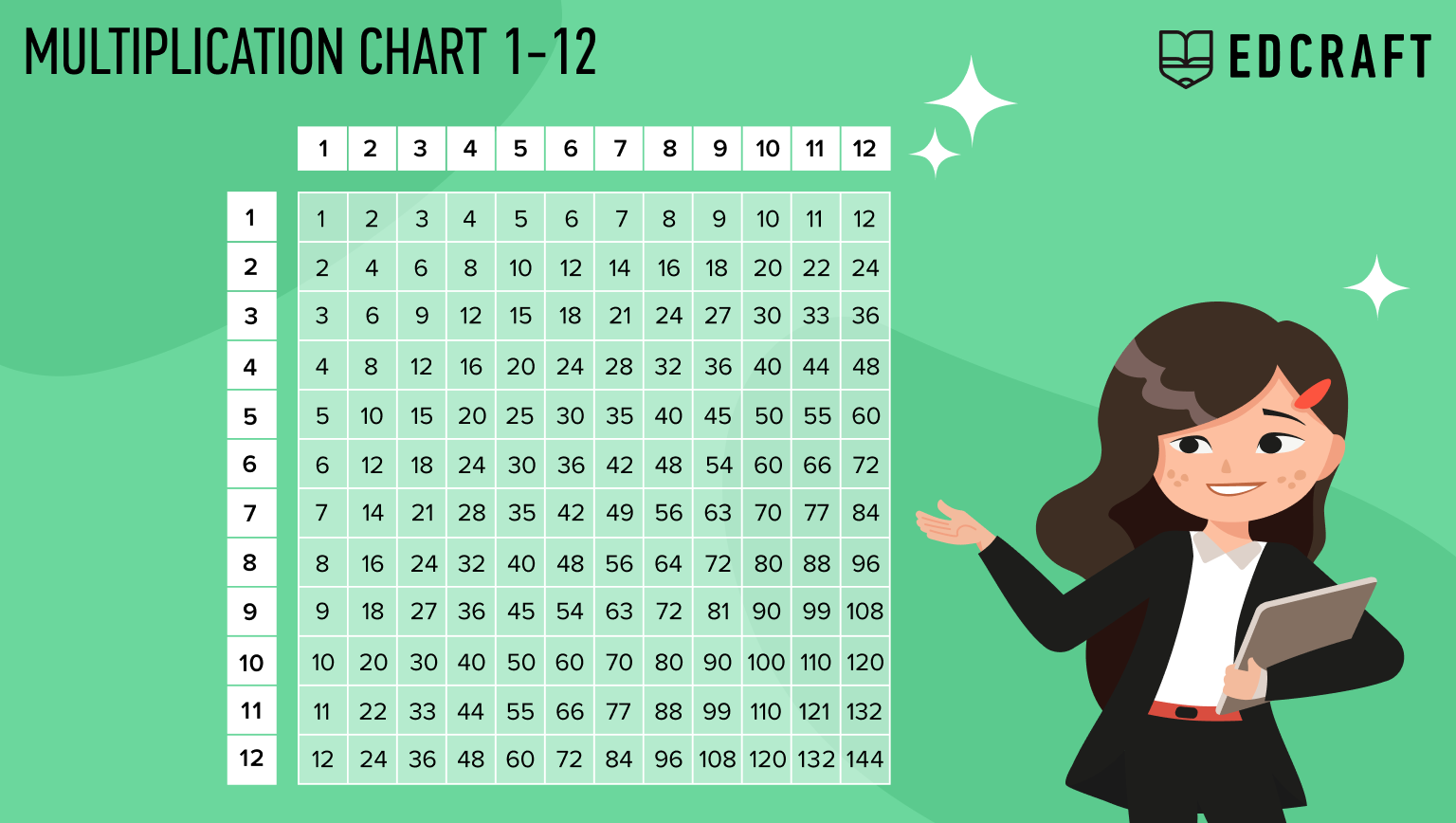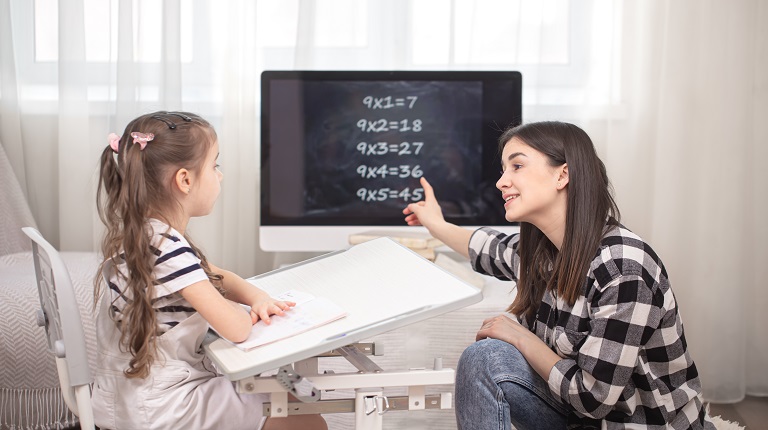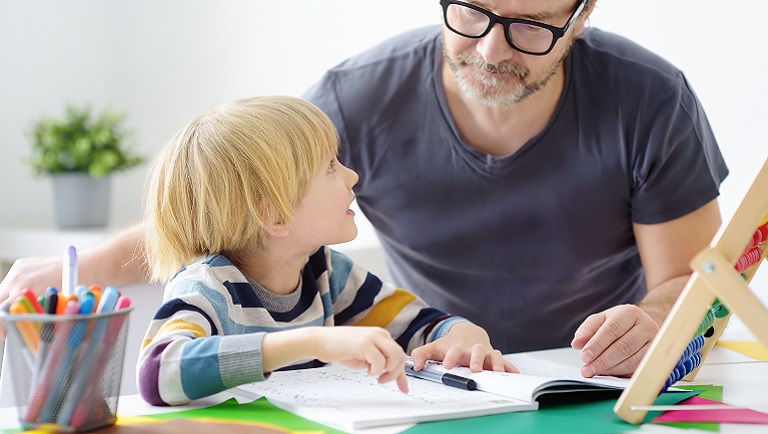
Muliplication charts for kids
After a kid masters counting and addition, it is time to move to the next level and learn multiplication. If you think about it, multiplication actually makes our calculations faster and easier. We use it quite often in our lives. Many of our everyday activities require that we can multiply both simple and more complex numbers. Next time you are in a supermarket, try not to use multiplication and use addition instead. You will see it is harder not to use multiplication than to use it. A kid will get that pretty quickly as well once he gets to the bottom of it.
What is multiplication?
Multiplication is a magical arithmetic action. It makes our calculations faster and more accurate. When we have big groups of things, it will take us twice as much time to add them together instead of multiplying.
Imagine you have six boxes of chocolates, each containing 10 chocolate sweets. How do you know how much you have altogether? If you start counting them by adding one to another first, you will have to remove them from the boxes and sum them up individually. How messy and inconvenient is that! And also tempting — it is much more fun to eat those sweets than count them for so long.
Instead, you can take them in groups and see how many of the groups you have. By the way, here is the first tip. Instead of saying ‘times’, as we are used to, it is more helpful to say ‘groups of’. Because in reality, when we multiply, we add groups of numbers together.

In a way, multiplication is a special way of adding: adding groups of numbers to each other. This way, it is clearer to kids why we need to use multiplication and what happens during it.
In our case, we have 6 groups of 10 chocolate sweets, unless someone has snuck in and secretly eaten a couple of pieces. But let’s think nobody around is that sweet tooth, and each box contains exactly 10 pieces. So what we can do is to multiply 10 sweets by 6 boxes:
- 6 × 10, or
- 6 groups of 10, or
- 10 + 10 + 10 + 10 +10 +10 = 60.
So, the main conclusion is that multiplication is just repeated addition. When we meet a situation where the same number is repeated several times, and we need to figure out the total amount, we can use multiplication. That’s why if you had eaten one sweet from one of those boxes, we would not have been able to include that box in our counting.
What is the multiplication chart, and how do you use it?
To make it easier to do our day-to-day calculations and remember some of them faster, we use a multiplication chart.
A multiplication chart is a table that shows the result of the multiplication of two numbers. It consists of columns and rows where each number from 1 to 12 has one row and one column.

The numbers we use are located in the left column and the top row — these are the numbers we multiply; they are called multipliers. The cells or the boxes of the table contain their product.
Let’s try to read it!
If you have ever used the addition table, you can skip this part as it is practically the same. Just instead of summing numbers, you multiply them.
The product of multiplication of two digits is the number at the intersection of the row and the column with the corresponding digits.
For example, to multiply 3 by 4, you can draw two lines with a marker or just mentally:
- one horizontal line from the cell containing digit 3 in the far left column
- and one vertical line from the cell with digit 4 in the top row.
The result is 12.
That’s how easy it is! Now try to practice it by yourself.
Why do multiplication charts only go to 12?
How about the rest of the digits?
It is believed that the multiplication table was first introduced into the school curriculum in England in the late Middle Ages. And it was a multiplication table up to 12, which is used to this day.
In the era of the British imperial system of measures and “non-decimal” money, everyone needed to count to 12 and use this number in various calculations. 1 foot is 12 inches, 1 pound sterling was 20 shillings, where 1 shilling was 12 pence.
Still, many people measure and count in inches (like the USA), and eggs are sold by the dozen or half dozen. But there is another thing as well. A child who can multiply digits greater than ten develops an understanding of how to multiply large numbers. Knowing the multiplication tables for 11 and 12 helps you notice interesting patterns that you could have missed if you had stopped at ten.
By the way, in India, students have to cram the original version of the Pythagorean table — 20 times table. So we are lucky.
Do children need to learn the multiplication table?
Nowadays, when we all have calculators inside our smartphones, practically on hand at all times, you may wonder why children need to learn the multiplication table.

First, it trains your memory. Technology does make our life easier, but any smart and educated person must be able to count on his own. Besides, people who cannot count in their heads often make mistakes when using a calculator. A shake of a hand, or just a mistake with a number you enter, and you get it all wrong.
Then, it’s just that everyday calculations are much easier to do in your mind automatically than to take out your phone and start calculating on it. For example, to estimate the cost of purchases and the rest at the grocery store. Or when you travel by car, you determine the time, distance, fuel supply for the trip. Any grown-up person estimates his income and figures how much he can spend this month.
Finally, the ability to do some basic math in your head, or rather, to estimate an approximate result, is an important tool in many spheres even today. When solving technical problems, fast counting allows inventors and engineers to instantly estimate the result, to imagine it.
Unfortunately, few people can do this effectively. But those who can manage more by working less. The ability to count is one of the important elements of solving many thinking tasks, a skill that increases prognostic abilities. Although most of the time, we do not even notice how useful counting is in many cases.
How to easily memorize the multiplication chart?
Here is some general advice on how to get acquainted with the multiplication chart without stress and tears.
Create a fun atmosphere
Often kids don’t understand why they need the multiplication chart at all. And they get angry that they have to memorize it. Learning by rote in an atmosphere of fear makes it only worse. It is an old-fashioned and extremely unfruitful way of studying. Instead, provide lots of engaging and interactive practice in a relaxed atmosphere to show what multiplication is good for. When there is understanding, memorization will come too.
Make sure your kid knows basic arithmetic
Before learning the multiplication table, make sure your child has no problems with addition and subtraction and can decompose numbers. Does he or she know that 6 + 9 can be decomposed into 6 + 4 + 5 = 10 + 5 and understand that it’s easy to count using ten?
Addition and subtraction will help when something is forgotten.
Help your child understand the meaning of multiplication
Does he or she get that 2 x 4 means 4 + 4?
Make it easier for a child by drawing rectangles on the table with sides corresponding to the numbers that are being multiplied. And invite your kid to count the number of boxes inside this rectangle. This way, he will discover that 2 × 4 = 8.
You can print as many copies as you want to draw other rectangles together: horizontal, vertical, small, and large ones, counting how many squares they have inside. By the way, it’s also great for training his visual memory.
Eliminate half of the table
Explain that the task is twice as easy as it seems. In other words, if you rearrange the multiplied numbers, the result will remain the same.
Let’s take the example from before. First, choose number 2 from the vertical column and number 4 from the horizontal line. Find the product together. Then choose 2 from the horizontal line and 4 from the vertical column. Notice that the result will still be the same: both 3 × 4 and 4 × 3 equal 12.
Do not rush; repeat instead
Teach in small portions. Start with multiplication by 1, 2, and 3 and spend a day or two practicing with each of them. This way, you will gradually prepare your child to absorb more complex information. Once he feels confident with these numbers, move on to the more difficult ones: multiplying by 4−7 and then multiplying by 8−9. Always repeat what he has learned. At first, ask him questions in order, then randomly.
Print educational posters
The more you have them, the better. You can stick them in the bathroom, kitchen, and children’s room. These posters should be large, bright, and fun. The child will cling to a colorful image, and it will stick in his memory.

Use patterns
Here are some handy patterns that will make memorization easier for your kid and you.
- Multiplying by 0 will always give 0: 0 + 0 + 0 + 0 = 0.
- Multiplying a number by 1 will give that number: as there is only one group of this number.
- Multiplying by 2 is always the same as adding the number to itself.
- Multiplying by 5 will always give a number that ends in either 0 or 5: 5, 10, 15, 20, etc.
- Multiplying by 9 has a curious pattern. The “ones” place goes down: 9, 18, 27, 36, 45, 54, 63, 72, 81, 90 and the “tens” place goes up: 1, 2, 3, etc.
- When you multiply a number by 10 just put a zero after it: 10 × 2 = 20, 10 × 3 = 30, etc.
Some tips and tricks on how to remember multiplication table

Now let’s go through other parts of the chart and show you some more tricks to memorize them!
Tips for the 3 times table
With a three, we also have a pattern that is just a little more complicated. It repeats every ten multiples of three.
Look at the first ten multiples of three:
- 3, 6, 9, 12, 15, 18, 21, 24, 27, 30.
And now take a look at the next ten multiples:
- 33, 36, 39, 42, 45, 48, 51, 54, 57, 60.
The last digit of the product always repeats, so you just need to remember the order of these digits and the digits themselves.
For example, numbers that end with a seven that you multiply by three will become numbers that end with one:
- 7 × 3 =21
- 17 × 3 = 51
- 27 × 3 = 81 and so on.
Tips tor the 4 times table
When you multiply a number by 4 you just double it two times:
- 7 × 4 → 7 + 7 = 14 → 14 + 14 = 28
Tips for the 6 times table
When you multiply by six an even number, the product will always end with the same digit as this number ends:
- 6 × 2 = 12
- 6 × 4 = 24
- 6 × 6 = 36
- 6 × 8 = 48
Tips for the 7 times table
In general, you will need to memorize the seven times table. But up to five multiples of seven, you can figure out from the previous tips. And here is a little memory trick for seven times eight. Think about counting upwards: 5, 6, 7, 8:
- 7 × 8 = 56
Tips for the 8 times table
As you can guess we are going to double again, in this case 3 times:
- 7 × 4 → 7 + 7 = 14 → 14 + 14 = 28 → 28 + 28 = 56.
Tips tor the 11 times table
This one is easy too. Up to 11 × 9, you just repeat the digit you are multiplying by eleven:
- 1 × 11 = 11
- 2 × 11 = 22
- 3 × 11 = 33
and so forth.
Tips for the 12 times table
When you multiply a number by twelve, just split the process into two parts. Twelve is ten plus two. So, first, multiply this number by ten which is super easy, then by two, and then just add them together.
12 × 4 becomes:
- 4 × 10 = 40 and 4 × 2 = 8
- 40 + 8 = 48
Math as a game: 4 fun multiplication chart games
Who said math should be boring and all about memorizing numbers? Today you can buy plenty of teaching aids with colorful pictures and logical tasks. Thanks to these exercises, learning becomes a fun game. Here are some engaging game-like activities that will help kids learn important math concepts while taking their minds off “boring numbers”.
1. Cards with numbers
You can make cards with multiplication cases without answers. Your kid picks a card and has to calculate the result. If he answers correctly, you put the card aside. Otherwise, you put it back in the stack. Whoever gives the most correct answers wins.
Another way to play the game is when you write a number on a card, and the kid has to think about all the multipliers that can produce this number.
2. Catch the ball
For this game, you need a ball. You pronounce two numbers and throw the ball. Your kid catches the ball, but before he can throw it back, he has to give you the product of multiplication of these numbers. Then you call another example and throw the ball to the kid again and so on. You can think of a prize for a certain amount of correct answers — something he wants badly.
3. Beat the Calculator!
All you need is a calculator and:
- dice if your child is learning 1 to 6 multiplication charts
- or a deck of playing cards without pictures if you’re multiplying numbers from 6 to 10.
Your kid rolls two dice or extracts two cards from the deck. When he sees the numbers, you multiply them on a calculator, and the child does the same in his head. Whoever is fastest gets the point. The winner gets a prize.
4. Tide pool skip counting math game
It is a very popular game and very simple to make. You need the game board, fish cards, and net. All these you can print out for free from the internet. Prepare a die, chips for each player, and paper with a pen.
The goal of the game is to collect as much fish as possible. But you can only catch the number of fish that is a multiple of 2 or 3. For that, you have to pick the right cards.
Players take turns rolling the die and moving around the field.
If a player stops at an animal cage, he gets no fish.
If the player stops at the square with words, he catches the specified number of fish. He takes the cards and puts them in his net.
When all players have reached the end, you calculate the catch. Whoever has more fish in the net wins.
For each kid, you may need to find a different way to teach the multiplication table. It does not matter how exactly he will learn it — the goal is to do it with pleasure.

new engaging articles



